Standard double barrelled pistols were pistols with non moving barrels that fired separately. In most cases two separate locks were employed, one for each barrel. Most of the time the lock were on either side of the pistol. In some over/under pistols, the locks were both on the same side but this was not the norm. Often one trigger fires both barrels. Some times a light pull will fire one barrel while a heavy pull fires both. A more common method was by the use of a small lever like trigger forward of the real trigger which the shooter would tap after the first barrel is discharged; this would reset the trigger for the second shot. A third method was that the shooter would not cock both dogheads preventing both barrels from firing.
Rotating or turn-barrels often have the traditional lock split in two. The doghead and trigger are on the main body of the pistol while the frizzen, pan and touch hole is part of the turning barrel mechanism. In order to fire the barrels, they are rotated by hand into firing position. Once in position the doghead is cocked and the pistol is fired.
A final multi-barrel is the tap action. Tap actions tended to be smaller pistols, similar to pocket or muff guns. Taps were often used a box-lock design with a single doghead and trigger. A small tap or lever was on the side of the pistol which allowed the shooter to redirect the sparks of the primer to different touch holes. It seems that tap actions were popular among the gentry as well as the cutthroats.
Multi-shot pistols were popular but also heavy and expensive to produce and sometimes unreliable.
Double barrelled over/under flintlock pistol

A simple yet elegant example of a double barrelled over/under pistol
The pistol has two locks but one trigger. By flipping the lever in front of the trigger, the second barrel is allowed to discharge. Firing is faster than with a turn-barrel because the barrels are not rotated. side by side double barrels were also produced.
Turn-barrels
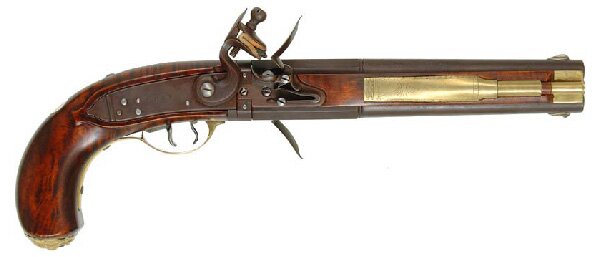
Pennsylvanian made Kentucky "swivel barrel" pistol
The front trigger acts as a barrel release to allow the shooter to swivel the unfired barrel into firing position
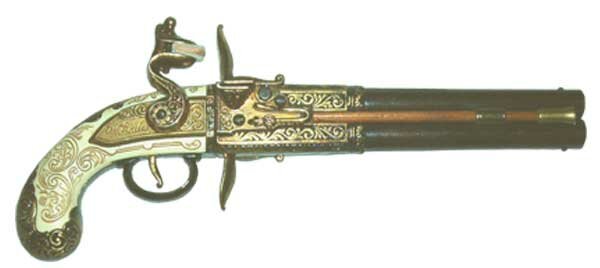
English multi-barrel pistol by Bailes of London
Barrels are rotated by hand. Each barrel has its on touch hole, pan and frizzen but there is only one doghead. Barrels are rotated by hand into firing position.
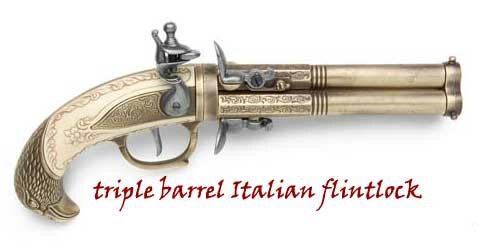
17th Century Italian Triple Barrel
Barrels are rotated by hand, one trigger, and one doghead but multiple frizzens and pans which allow the barrels to be primed in advanced and then be rotated into place after the weapon is half cocked.
Tap Actions
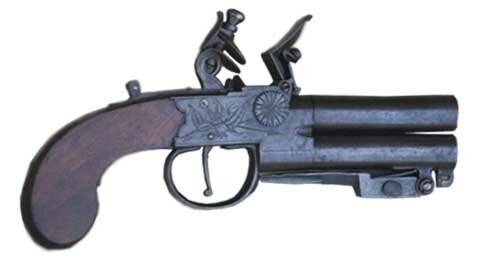
Late 17th Century Tap Action Pistols.
After the first shot is fired the shooter taps a small lever (on the left side of the pistol, not shown). After the lever is "tapped" the second barrel can be fired once the pistol is re-primed and re-cocked. Tap action pistols were quite popular. Typical calibers ranged between 40 and 45 calibers. This model is a box lock which also features a small, spring loaded, triangular bayonet. Some tap actions also had the barrels side by side. In some case the barrels screw off. in other cases they are muzzle loaders. Below is a close up of the pan with the two touch holes. a tunr of the lever directs which barrel fires. Re-priming the pan was noramlly ncessary.
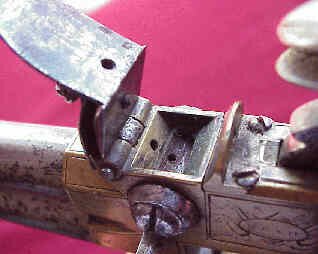

The only author and editor of all pages on the site. Most of what I write about is based on years of book reading on the topic. My first web page was published back in 1994.